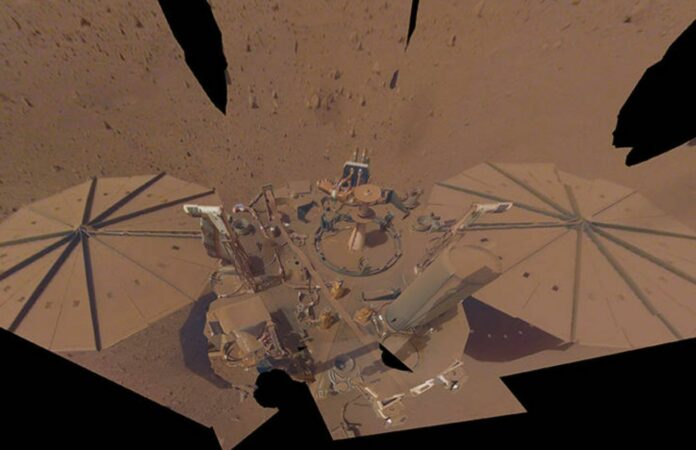As a continent-sized dust storm churns across Mars’ southern hemisphere, NASA’s soon-to-end InSight mission has seen a recent dip in power provided by its solar panels. The storm was first seen by NASA’s Mars Reconnaissance Orbiter (MRO) on September 21, 2022. It is about 2,175 miles (3,500 kilometers) from InSight and had little effect on the lander at first.
The mission keeps a close eye on the lander’s power level, which has been dropping steadily as dust has settled on its solar arrays. By Monday, Oct. 3, the storm had gotten big enough and was spewing out enough dust to raise the dusty haze’s thickness around InSight by almost 40%. The lander’s energy decreased from 425 watt-hours each Martian day, or sol, to barely 275 watt-hours per sol as a result of less sunshine hitting its solar panels.
Every other Martian day, InSight’s seismometer has been running for nearly 24 hours. However, there is not enough energy left after the reduction in solar output to fully recharge the batteries every sol. The lander could only function for a few weeks at the current rate of discharge. Therefore, the mission will disable InSight’s seismometer for the following two weeks in order to save energy.
“We were at about the bottom rung of our ladder when it comes to power. Now we’re on the ground floor,” added InSight’s project manager, Chuck Scott of NASA’s Jet Propulsion Laboratory in Southern California. “If we can ride this out, we can keep operating into winter – but I’d worry about the next storm that comes along.”
The team predicted that InSight’s mission will end between late October of this year and January of 2023, depending on how much the dust on its solar panels will diminish the spacecraft’s power generation. The lander is nearing the completion of its extended mission, conducting “bonus science” by measuring marsquakes, which provide information about the Red Planet’s deep innards. The lander has long since completed its original goal.
Investigation of Martian Storms
There are signs that this big, regional storm has reached its peak and is now starting to lose strength: The storm’s expansion is slowing down, according to MRO’s Mars Climate Sounder instrument, which analyzes the heating brought on by dust absorbing sunlight. Additionally, the orbiter’s Mars Color Imager camera, which makes daily global images of the Red Planet and was the first sensor to identify the storm, has seen that the dust-raising clouds are not growing as quickly as they were.
This is the third storm of its kind this year, so it shouldn’t come as a surprise that it’s hitting the region. In reality, Mars has dust storms during the whole Martian year, but northern fall and winter, which is now ending, sees the greatest number and size of them.
Mars’ dust storms are not as fierce or spectacular as portrayed by Hollywood. Although winds on Mars can reach speeds of up to 60 miles per hour (97 kilometers per hour), these winds have just a small fraction of the power of storms on Earth. The storms are typically filthy; they send billowing clouds of dust up into the atmosphere, where it slowly descends, sometimes over the course of weeks.
Rarely, dust storms have grown into planet-encircling dust occurrences that blanket almost all of Mars, according to experts. In 2018, one of these dust storms the size of a planet destroyed NASA’s solar-powered Opportunity rover.
The NASA Curiosity and Perseverance rovers don’t have to worry about a dust storm hurting their energy because they are nuclear-powered. The Ingenuity helicopter, however, has become aware of the general increase in background haze.
MRO has spent 17 years gathering important information about how and why storms form on Mars. This information is used to make sure that NASA missions on the surface of Mars are safe.
“We’re trying to capture the patterns of these storms so we can better predict when they’re about to happen,” Zurek added. “We learn more about Mars’ atmosphere with each one we observe.”
Image Credit: Getty
You were reading: A Dust Storm Size Of Continent Challenges NASA’s InSight Mission
